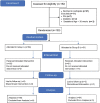Comparative Evaluation of Intrathecal Dexmedetomidine and Fentanyl as an Adjuvant for Combined Spinal-Epidural Analgesia for Labor
- PMID: 36447912
- PMCID: PMC9701333
- DOI: 10.4103/aer.aer_73_22
Comparative Evaluation of Intrathecal Dexmedetomidine and Fentanyl as an Adjuvant for Combined Spinal-Epidural Analgesia for Labor
Abstract
Background: Combined spinal-epidural technique is a widely accepted and popular modality for labor analgesia. Opioids are being used as adjuvants since long time. Dexmedetomidine is a new drug that is being used as an intrathecal adjuvant.
Aim: The study aims to compare the safety and efficacy of fentanyl and dexmedetomidine as intrathecal adjuvants in labor analgesia.
Settings and design: This was a continuous, prospective, randomized controlled trial with 120 parturients.
Materials and methods: After ethical approval and written consent, participants were divided randomly into two groups: Group A - bupivacaine 2.5 mg (0.5 mL diluted to 2 mL) + 20 μg of dexmedetomidine in 1 mL saline intrathecally (total volume: 3 mL) and Group B - bupivacaine 2.5 mg (0.5 mL diluted to 2 mL) + 15 μg of fentanyl in 1 mL saline intrathecally (total volume: 3 mL). Primary outcomes were satisfactory analgesia, mode of delivery, and neonatal outcome. Participants were monitored for the onset and duration of analgesia, degree of motor block, and maternal and fetal side effects.
Results: A total of 108 parturients reported sufficient analgesia (Group A: 57; Group B: 51), and 74 patients delivered vaginally (Group A: 41; Group B: 44). The rates of normal vaginal delivery were higher in Group B. Group A reported earlier onset of analgesia (61.26 ± 18.23 s) that lasted for longer duration (124.16 ± 26.23 min) than in Group B. There were no serious side effects in any of the groups. Fetal ultrasound revealed attenuation of fetal heart rate variability. The heart rate of newborns was also found to be low in Group A.
Conclusion: Chances of vaginal delivery are higher with intrathecal fentanyl as an adjuvant. Intensity and duration of analgesia are better with intrathecal dexmedetomidine.
Keywords: Dexmedetomidine; fentanyl; labor analgesia.
Copyright: © 2022 Anesthesia: Essays and Researches.
Conflict of interest statement
There are no conflicts of interest.
Figures
Similar articles
-
Comparision of efficacy of sufentanil and fentanyl with low-concentration bupivacaine for combined spinal epidural labour analgesia.Indian J Anaesth. 2012 Jul;56(4):365-9. doi: 10.4103/0019-5049.100819. Indian J Anaesth. 2012. PMID: 23087459 Free PMC article.
-
Intrathecal dexmedetomidine improves epidural labor analgesia effects: a randomized controlled trial.J Int Med Res. 2021 Apr;49(4):300060521999534. doi: 10.1177/0300060521999534. J Int Med Res. 2021. PMID: 33827306 Free PMC article. Clinical Trial.
-
Comparison of epidural dexmedetomidine to fentanyl in reducing ropivacaine dose in Programmed Intermittent Epidural Bolus plus Patient Controlled Epidural Analgesia during labor: A randomized, double-blind, controlled study.Front Med (Lausanne). 2022 Oct 17;9:935643. doi: 10.3389/fmed.2022.935643. eCollection 2022. Front Med (Lausanne). 2022. PMID: 36325391 Free PMC article.
-
Comparative Efficacy of Minimal Concentration of Racemic Bupivacaine (0.0625%) with Fentanyl and Ropivacaine (0.1%) with Fentanyl for Epidural Labor Analgesia.Anesth Essays Res. 2017 Jul-Sep;11(3):583-588. doi: 10.4103/aer.AER_63_17. Anesth Essays Res. 2017. PMID: 28928552 Free PMC article.
-
Sufentanil versus fentanyl for pain relief in labor involving combined spinal-epidural analgesia: a systematic review and meta-analysis of randomized controlled trials.Eur J Clin Pharmacol. 2020 Apr;76(4):501-506. doi: 10.1007/s00228-019-02806-x. Epub 2020 Jan 7. Eur J Clin Pharmacol. 2020. PMID: 31912188
Cited by
-
A Systematic Review of Contemporary and Emerging Analgesia Techniques for Natural Labor-Patient-Centered Approaches and Technological Advances.J Clin Med. 2025 Jun 5;14(11):3977. doi: 10.3390/jcm14113977. J Clin Med. 2025. PMID: 40507739 Free PMC article. Review.
References
-
- Cohen J. Doctor James Young Simpson, Rabbi Abraham De Sola, and Genesis, 1996. Chapter 3, verse 16. Obstet Gynecol. 1996;88:895–8. - PubMed
LinkOut - more resources
Full Text Sources


